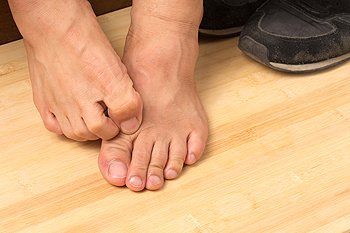
 A rash on the skin of the feet may be indicative of a fungus that is referred to as athlete's foot. It is considered to be contagious, and can spread from sharing towels, socks, and shoes. Additionally, it is generally found in places that include shower room floors, public swimming pools, locker room floors, and surrounding areas. Some of the symptoms that are typically associated with this condition can include itchy feet, and the skin may also peel and crack. There are different types of athlete's foot and symptoms can vary depending on the diagnosis. A toe web infection can be found between the toes and the skin typically cracks and peels. If an outbreak of sudden blisters become present this may indicate a vesicular infection. Originating with foot soreness, followed by thickened and cracked skin on the sole of the foot may suggest a moccasin-type infection. If you are afflicted with athlete's foot it is suggested to make an appointment with a podiatrist who can recommend the best treatment for you.
A rash on the skin of the feet may be indicative of a fungus that is referred to as athlete's foot. It is considered to be contagious, and can spread from sharing towels, socks, and shoes. Additionally, it is generally found in places that include shower room floors, public swimming pools, locker room floors, and surrounding areas. Some of the symptoms that are typically associated with this condition can include itchy feet, and the skin may also peel and crack. There are different types of athlete's foot and symptoms can vary depending on the diagnosis. A toe web infection can be found between the toes and the skin typically cracks and peels. If an outbreak of sudden blisters become present this may indicate a vesicular infection. Originating with foot soreness, followed by thickened and cracked skin on the sole of the foot may suggest a moccasin-type infection. If you are afflicted with athlete's foot it is suggested to make an appointment with a podiatrist who can recommend the best treatment for you.
Athlete’s Foot
Athlete’s foot is often an uncomfortable condition to experience. Thankfully, podiatrists specialize in treating athlete’s foot and offer the best treatment options. If you have any questions about athlete’s foot, consult with Dr. Sybil J. Fisher from Texas. Our doctor will assess your condition and provide you with quality treatment.
What Is Athlete’s Foot?
Tinea pedis, more commonly known as athlete’s foot, is a non-serious and common fungal infection of the foot. Athlete’s foot is contagious and can be contracted by touching someone who has it or infected surfaces. The most common places contaminated by it are public showers, locker rooms, and swimming pools. Once contracted, it grows on feet that are left inside moist, dark, and warm shoes and socks.
Prevention
The most effective ways to prevent athlete’s foot include:
Symptoms
Athlete’s foot initially occurs as a rash between the toes. However, if left undiagnosed, it can spread to the sides and bottom of the feet, toenails, and if touched by hand, the hands themselves. Symptoms include:
Diagnosis and Treatment
Diagnosis is quick and easy. Skin samples will be taken and either viewed under a microscope or sent to a lab for testing. Sometimes, a podiatrist can diagnose it based on simply looking at it. Once confirmed, treatment options include oral and topical antifungal medications.
If you have any questions, please feel free to contact one of our offices located in Houston and Sugar Land, TX . We offer the newest diagnostic and treatment technologies for all your foot care needs.
Read more about How to Deal with Athlete's Foot
Copyright © 2016 S.J. Fisher DPM | Site Map | Design by: Podiatry Content Connection